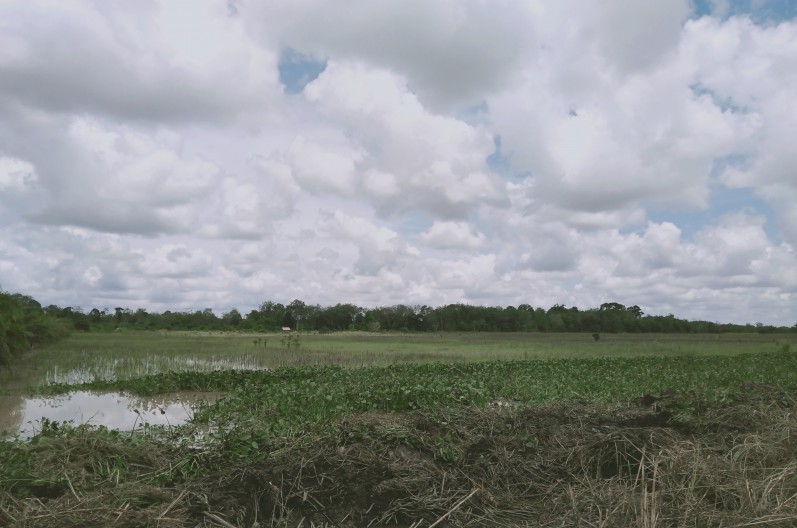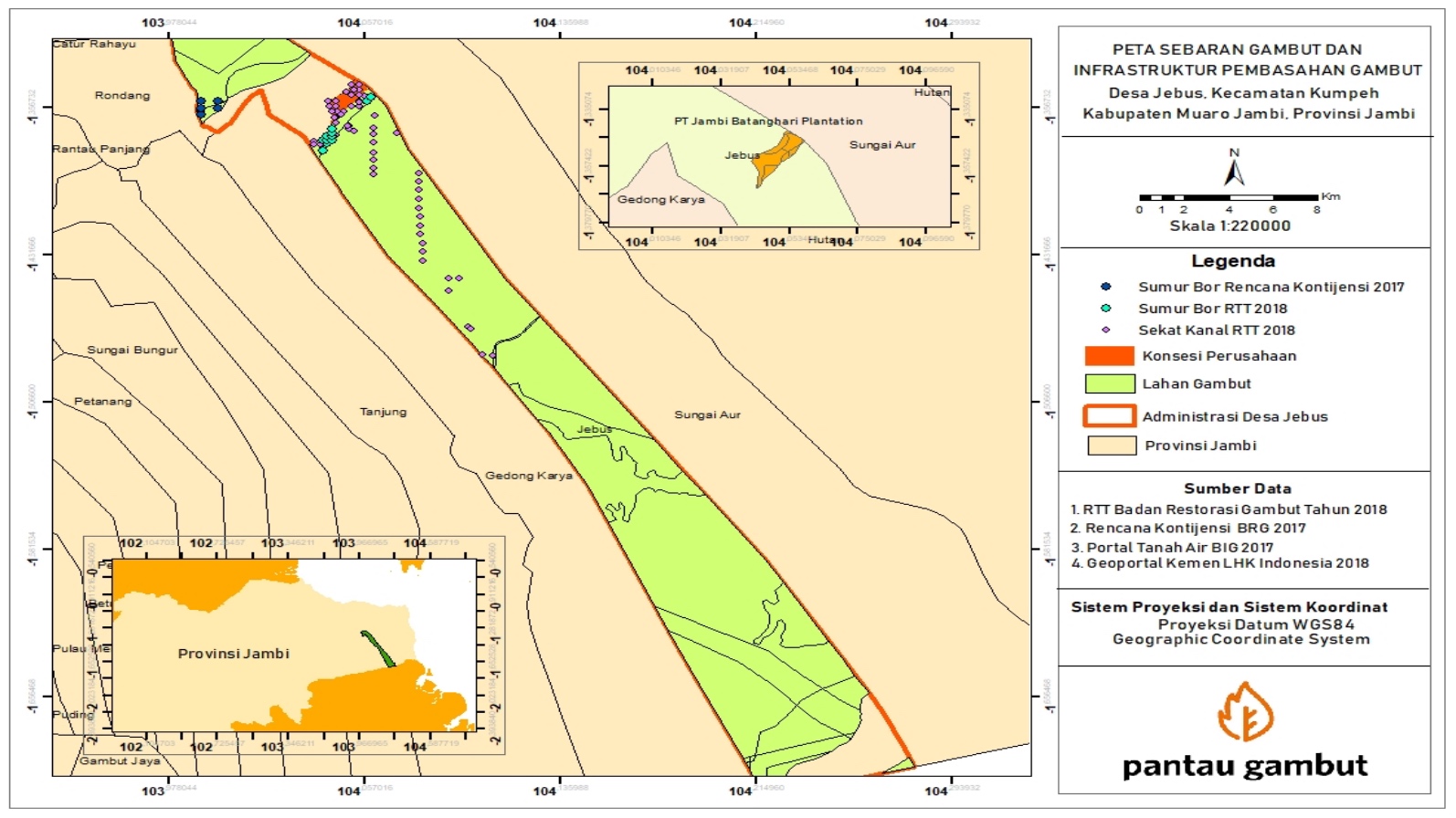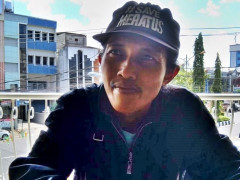Asap Masih Menghampiri Wilayah Suak Batok
By Parliza HendrawanJebus’ Hope on the Village Regulation on Peatland

Jebus Village is one of five villages in Kumpeh Subdistrict, Muarojambi District, which already has a Village Regulation concerning the Protection of Peatlands for Food Crops Agriculture and Sustainable Plantation. However, after almost three years, there has been no implementation or visible impact of the village regulation that can support the peat restoration program in Jambi. To make it works, the local government and all stakeholders need to encourage its implementation so that the village regulation can have a real impact on the sustainability of food agriculture on peatlands.
Daud took a sip of his kretek cigarette while watching heavy equipment clearing a canal on a corn farm on the roadside of Jebus Village, Kumpeh Subdistrict, Muaro Jambi District, Jambi Province. Daud's face was happy because he could start working on his land and plant corn in the following month. Daud believed that after the canal is cleared, the water inundating his peatland would begin to dry up.
Daud, who was wearing a green sleeveless t-shirt that afternoon, went to the kitchen to prepare ice tea. The weather during the day in mid-April was very hot. A cool drink could freshen up the workers who were clearing the canal from water hyacinth.
"Agricultural peatland requires different treatment. Sometimes it's dry, sometimes it's flooded like now. Our land is still inundated but maybe starting next month we can start working on it. We plant corn here," said Daud when we met him in Jebus Village on Friday (19 April 2019).
When heavy equipment cleared piles of water hyacinth, some residents came and approached the canal within a safe distance. They carried buckets to look for fish that had been carried away from the canal. They are snakehead murrel (Channa striata), fish that typically lives in peat swamps.
"Every time we enter the planting season, the villagers start to get busy. We also ask the company to help with their heavy equipment," said Daud.
A week before the planting season and after the land was dry, the residents of Jebus Village started plowing the land. Daud said that usually, the farmers in the village did not burn the land to cultivate it because they were not clearing new land. Some people still cleared new land by burning but according to the local regulation, land clearing by burning can only be done in the afternoon when the sun is not too hot and must be watched by the residents to prevent the fire from spreading.
Before the planting period, the residents hold a thanksgiving ritual to ask for blessings from the Creator so that the crops will thrive and be free from pests. They jointly buy a goat for the ritual. After the thanksgiving ritual, they will start planting Bisi-2 super corn.
Village Regulation on Peat Protection
Jebus Village, which is administratively located in Kumpeh Ilir Subdistrict, Muaro Jambi, is located in the territory of two Peat Hydrological Units (KHG), i.e. the Batang Hari River - Air Hitam Laut Unit and the Mendahara River - Batanghari River Unit. Jebus Village consists of mostly peatlands with an area of 116,028 hectares. These two Peat Hydrological Units are included in the priority restoration program for 2 million hectares of peatland.
Based on the 2017 Contingency Plan from the Peatland Restoration Agency (BRG), the planned restoration activities in Jebus include the construction of rewetting infrastructure, i.e. 5 drilled wells. In the following year, based on the 2018 Annual Action Plan (RTT) from BRG, the construction of wetting infrastructure includes 11 drilled wells and 64 canal blocks.
The local village government also supports the efforts to restore and protect peatlands by taking the initiative to issue a village regulation (Perdes). In 2017, Jebus Village officially has a legal basis in the form of Village Regulation No. 01 of 2017 concerning Protection of Peatlands for Food Crops Agriculture and Sustainable Plantation.
According to the Village Secretary, Jamaludin, one of the points contained in the regulation is that the Village Government provides incentives to farmers based on soil fertility, planting area, irrigation, land fragmentation level, farm productivity, farm collectivity location, and environmentally friendly farming practices through the concept of land clearing without burning.
Jamaludin said that the Village Regulation is important for his village because it is located on peatland.
“In the Village Regulation, there are provisions on providing incentives for farmers who run environmentally friendly farming and sanctions for farmers who are not environmentally friendly. Besides protecting peatlands for food agriculture, it is also to prevent the conversion of agricultural land because Jebus Village is not far from the oil palm plantations," said Jamaludin.
Based on spatial data processed by Pantau Gambut, there is PT Jambi Batanghari Plantation work area within Jebus Village administrative area (see map). According to the National Statistics Agency (BPS) data in “Kumpeh District in Figures 2018”, 20,250 square meters of land in Jebus Village is village government-owned land (TKD) which is planted with oil palm as the main commodity.
The existence and development of this oil palm plantation had raised concerns over the possibility of food agricultural land conversion. It was this concern that contributed to the issuance of Village Regulation on Peatland in Jebus.
The expansion of oil palm plantations has made some people tempted to sell their land and eventually work as laborers in companies for a wage of around IDR 2,000,000 according to the Jambi provincial minimum wage.
"The village regulation has a simple purpose, which is to ensure that agricultural land is not converted into oil palm plantations," said Jefri Nurrahman, Program Manager of the Walestra Organization.
Jefri was one of the initiators who assisted five villages in Kumpeh to issue a village regulation that protects peatlands for food agriculture. Currently, five villages have the same village regulations, i.e. Seponjen Village, Sogo Village, Gedong Karya Village, Jebus Village, and Sungai Air Village. In total, the five villages have 700 hectares of agricultural land on shallow peatlands.
Apart from protecting the environment and food agriculture, the Village Regulation on Peatland in Jebus is also expected to counterbalance the social changes brought about by oil palm plantations. According to Jefri, currently around 70 percent of women in Jebus are laborers in oil palm plantations and rarely work in paddy fields. Whereas in the past, women dominated the work in paddy fields while men were in charge of moving crops from the fields to their homes.
“In Jebus, paddy farming is not just a matter of food but it's part of the division of roles between men and women. The problem is that the community lands were sold by the men so the women lost the area where they could carry out their main role and instead became laborers in the companies," said Jefri.
However, three years after it was issued, the Village Secretary, Jamaludin, admitted that the village regulation hasn’t done much. Besides supporting peatland restoration, the village regulation can be the basis and reference for the village government in preparing the Village Government Work Plan (RKPDes) and the Village Medium-Term Development Plan (RPJMDes) related to peatland protection for food agriculture. With the village regulation in hand, the village government can also allocate village funds and other funds for land management and capacity building for farmers.
Not many villagers know about this regulation. The lack of dissemination to residents is one cause of this ignorance.
This was also acknowledged by a female farmer, Rusna. "We don't know that there is a regulation. Farmers only know to work on the land," he said.
"Now it’s up to the village government to take action, for example, by allocating funds to assist farmers and support community agriculture. There won’t be any problem if the village government takes action because the farmers need financial support to successfully develop food agriculture on peatlands," concluded Jefri.





